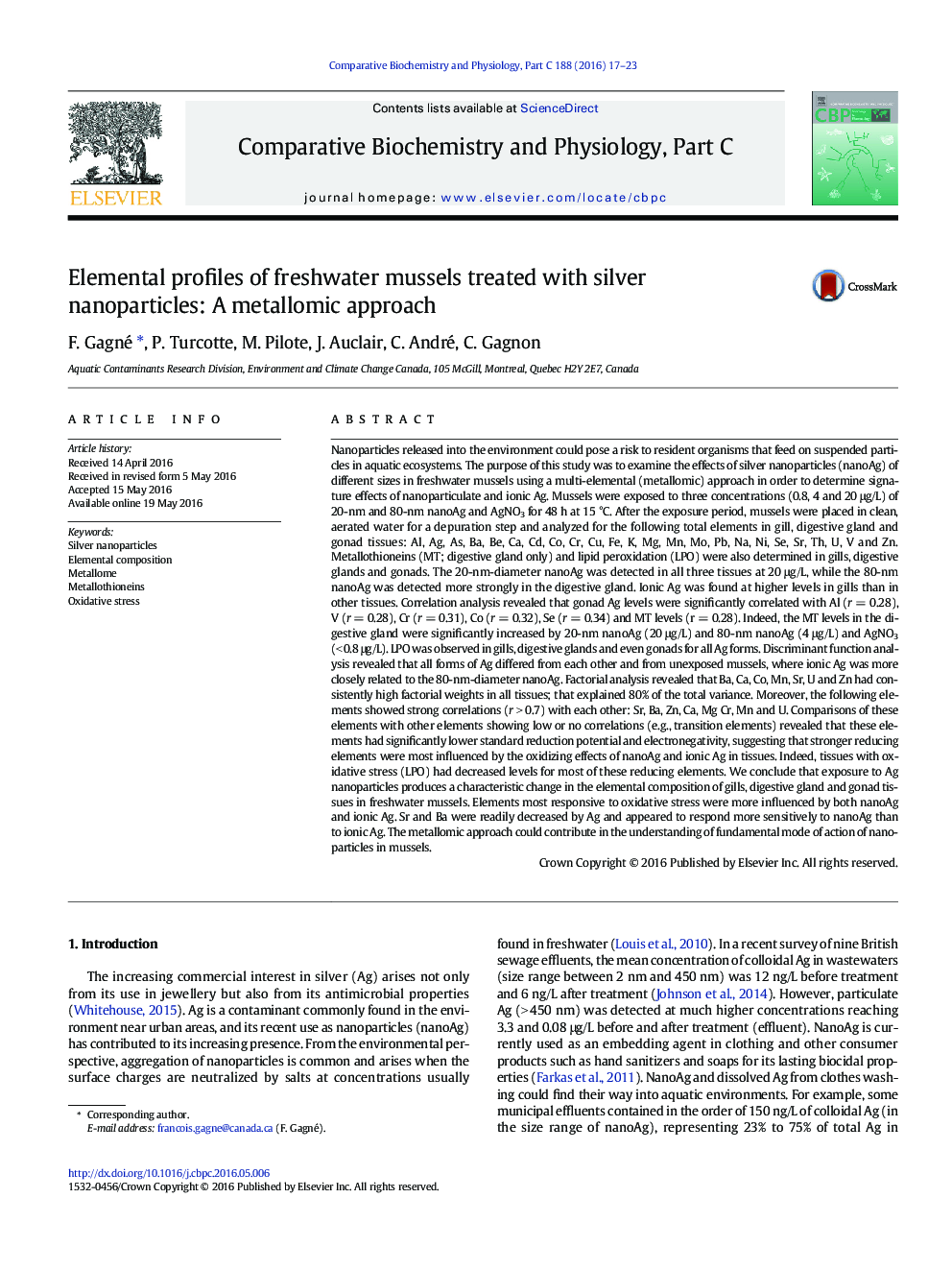| Article ID | Journal | Published Year | Pages | File Type |
|---|---|---|---|---|
| 1977103 | Comparative Biochemistry and Physiology Part C: Toxicology & Pharmacology | 2016 | 7 Pages |
Nanoparticles released into the environment could pose a risk to resident organisms that feed on suspended particles in aquatic ecosystems. The purpose of this study was to examine the effects of silver nanoparticles (nanoAg) of different sizes in freshwater mussels using a multi-elemental (metallomic) approach in order to determine signature effects of nanoparticulate and ionic Ag. Mussels were exposed to three concentrations (0.8, 4 and 20 μg/L) of 20-nm and 80-nm nanoAg and AgNO3 for 48 h at 15 °C. After the exposure period, mussels were placed in clean, aerated water for a depuration step and analyzed for the following total elements in gill, digestive gland and gonad tissues: Al, Ag, As, Ba, Be, Ca, Cd, Co, Cr, Cu, Fe, K, Mg, Mn, Mo, Pb, Na, Ni, Se, Sr, Th, U, V and Zn. Metallothioneins (MT; digestive gland only) and lipid peroxidation (LPO) were also determined in gills, digestive glands and gonads. The 20-nm-diameter nanoAg was detected in all three tissues at 20 μg/L, while the 80-nm nanoAg was detected more strongly in the digestive gland. Ionic Ag was found at higher levels in gills than in other tissues. Correlation analysis revealed that gonad Ag levels were significantly correlated with Al (r = 0.28), V (r = 0.28), Cr (r = 0.31), Co (r = 0.32), Se (r = 0.34) and MT levels (r = 0.28). Indeed, the MT levels in the digestive gland were significantly increased by 20-nm nanoAg (20 μg/L) and 80-nm nanoAg (4 μg/L) and AgNO3 (< 0.8 μg/L). LPO was observed in gills, digestive glands and even gonads for all Ag forms. Discriminant function analysis revealed that all forms of Ag differed from each other and from unexposed mussels, where ionic Ag was more closely related to the 80-nm-diameter nanoAg. Factorial analysis revealed that Ba, Ca, Co, Mn, Sr, U and Zn had consistently high factorial weights in all tissues; that explained 80% of the total variance. Moreover, the following elements showed strong correlations (r > 0.7) with each other: Sr, Ba, Zn, Ca, Mg Cr, Mn and U. Comparisons of these elements with other elements showing low or no correlations (e.g., transition elements) revealed that these elements had significantly lower standard reduction potential and electronegativity, suggesting that stronger reducing elements were most influenced by the oxidizing effects of nanoAg and ionic Ag in tissues. Indeed, tissues with oxidative stress (LPO) had decreased levels for most of these reducing elements. We conclude that exposure to Ag nanoparticles produces a characteristic change in the elemental composition of gills, digestive gland and gonad tissues in freshwater mussels. Elements most responsive to oxidative stress were more influenced by both nanoAg and ionic Ag. Sr and Ba were readily decreased by Ag and appeared to respond more sensitively to nanoAg than to ionic Ag. The metallomic approach could contribute in the understanding of fundamental mode of action of nanoparticles in mussels.
